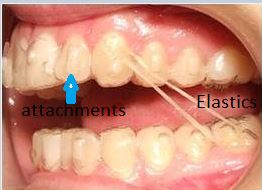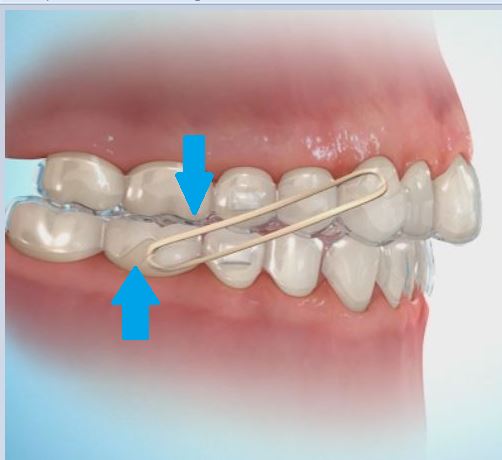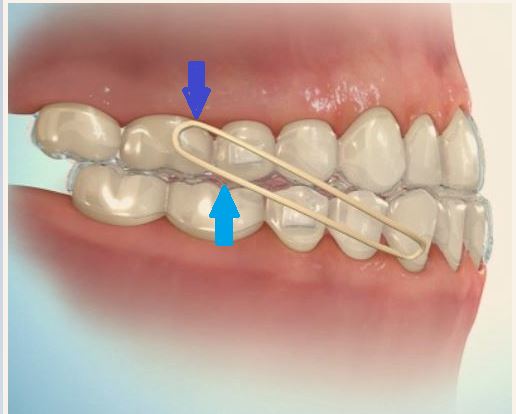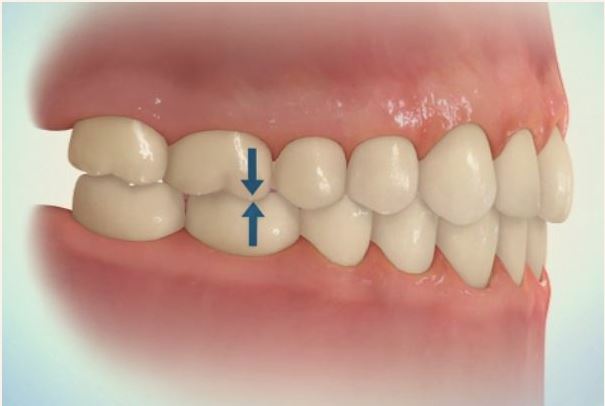Invisalign is one brand of clear aligner , clear aligners are all the rage in orthodontics currently.You can hardly view social media, or watch T.V. without being exposed to an advertisement for some type of plastic aligner system that offers you a new smile.The biggest company in the aligner market is Align Technology who produce Invisalign clear aligners. They have an absolutely huge advertising budget and their aligners have become a household name like Kleenex and Elastoplast.
Patients are sometimes surprised to learn that if you are having treatment with invisalign that more than just aligners are commonly required e.g attachments as described in the previous blog from Clonmel Orthodontics and possibly the use of elastics with invisalign which is the topic for this blog.
It is not always just a case of simply popping your aligner in, wearing it for 22 hours a day and taking it out to brush floss and eat;then regularly changing onto a new set aligners as prescribed by your orthodontist, until your teeth are beautifully straight. This maybe the case if you only have a minor problem. (Though attachments will nearly always be required. The use of attachments improves the quality of the result achieved, and without them certain orthodontic tooth movements are simply not possible.)
What is described in the paragraph above seems easy and it would be if we lived in an ideal world. Unfortunately this is not always the case, particularly when invisalign is used to treat more complex cases. For more complex problems invisalign treatment often requires more than just the aligners alone , elastics are one example of applying an orthodontic force in combination with invisalign.
The key to understanding the rationale for elastics is to appreciate that the most that an upper orthodontic appliance (braces or invisalign) alone can do is to get the upper teeth straight. Similarly the most that a lower orthodontic appliance can do is to get the lower teeth straight.
Elastics are normally used to improve how your upper teeth (as a unit) and your lower teeth (as a unit) meet together, that is the occlusion of the teeth.
It is obviously important that the upper and lower teeth meet together properly, as they function much like the opposing blades of a scissors. The meeting point (or occlusion ) is important if they are to function properly. One of the ways of adjusting the position of the upper teeth relative to the lower is to use elastics. The important point to understand is that some means has to be used to apply a force between the upper and lower teeth to adjust their relative position. Elastics are a way that is commonly applied to do this. The direction of the elastics varies as seen in the two pictures above depending on the type of movement required. The third picture represents the ideal occlusion (bite). There are numerous configurations for the elastics.
With invisalign the means of attachment of the elastics is either through buttons bonded directly to the teeth , or through the use of so called “precision cuts” which are essentially slits in the plastic of the aligners to accomodate the elastics.
The elastics are generally worn 22 hours per day, either for part or the whole of your invisalign treatment. Generally they are worn in pairs. The patient replaces the elastic at least once a day to keep it fresh. They are removed for eating and replaced afterwards. It is important that the elastics are worn as prescribed otherwise the final result achieved will not be as good.
……………………………………………………………………………………………..
This orthodontic blog was written by Dr John Buckley ,who is a specialist orthodontist at Clonmel Orthodontics in Clonmel County Tipperary, Ireland.He is both Clonmel’s most qualified and most experienced orthodontist.
Clonmel Orthodontics provides orthodontics to county Tipperary and the neighbouring counties of Waterford, Kilkenny, Limerick,Cork , and beyond.
Dr Buckley has practised as a specialist orthodontist in Clonmel for over 20 years. In addition to his orthodontic qualifications which he held before he commenced orthodontic practice , Dr Buckley was awarded a First class masters degree in Lingual orthodontics from the University of Hannover medical school (MHH) in 2012. This masters degree is directed by Professor Dirk Wiechmann who is the inventor of both the incognito™ and win™ lingual appliances. Dr Buckley was the first orthodontist in Ireland to be awarded this qualification. In 2016 he was accepted as an active member of the European Society Of Lingual Orthodontics (ESLO). To become an active member it is necessary for candidates to submit the records of finished lingual cases. If the cases are deemed to be of a sufficiently high standard then the candidate is accepted as an active member of ESLO. Dr Buckley is the first and only orthodontist in Ireland to be accepted as an active member of ESLO.





